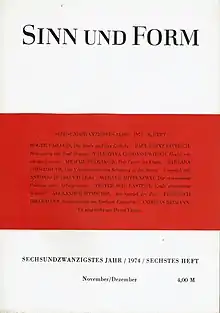 Cover page dated 1974 | |
| Editor-in-chief | Matthias Weichelt |
|---|---|
| Categories |
|
| Frequency | Bimonthly |
| Publisher | Akademie der Künste |
| Founder |
|
| First issue | 1949 |
| Country | Germany |
| Based in | Berlin |
| Language | German |
| Website | sinn-und-form |
| ISSN | 0037-5756 |
Sinn und Form (German: Sense and Form) is a bimonthly literary and culture magazine. It was launched in East Berlin, East Germany, in 1949 and is still in circulation. The magazine describes itself as one of the definitive cultural journals in Germany.[1]
History and profile
The magazine was established by Johannes R. Becher and Paul Wiegler in 1949.[2][3] The original title was Maß und Wert (German: Measure and Value).[4] When it was published in the East Germany, the magazine was employed by the ruling party, Socialist Unity Party, as a media outlet for its cultural policy.[5] However, the magazine was not enthusiastic about this relationship.[5] Because since its start it has had a unique style which is apolitical.[3] It covers articles on poetry and philosophy, anthropology and theology and the relations between art and science.[3] It provides essays, poems, stories, diaries, letters and conversations on these topics.[3]
In 1975 a novel by Volker Braun entitled Unvollendete Geschicht was published in the magazine, but the novel was not published as a book in East Germany and appeared as a print book only in 1998.[6]
Sinn und Form is published by the Akademie der Künste in Berlin on a bimonthly basis.[2] The magazine has been the subject of the scholarly analysis, and at least two books were published about the magazine.[7][8]
Editors and contributors
The editors-in-chief of the magazine include the following:[9]
- Peter Huchel (1949–1962)
- Bodo Uhse (1963)
- Wilhelm Girnus (1964–1981)
- Paul Wiens (1982)
- Max Walter Schulz (1983–1990)
- Sebastian Kleinschmidt (1991–2013)
- Matthias Weichelt (2013–)
Notable contributors of Sinn und Form are Miguel Ángel Asturias, Imre Kertész, Halldór Laxness, Czeslaw Milosz, Pablo Neruda, Romain Rolland, Jürgen Habermas, Nelly Sachs, Heiner Müller, Ernst Jünger, Hilde Domin, Volker Braun, Peter Härtling, Durs Grünbein, and Jürgen Becker.[1][10] During the editorship of Peter Huchel the magazine featured the work by German and international non-Communist writers, and unpublished works by Bertolt Brecht were published in two special issues of the magazine.[11] Robert Havemann, chemist and later dissident, published articles in the magazine criticizing modern socialism and revisionist works of the Western authors.[12]
The founding editor-in-chief Peter Huchel was forced by the East German authorities to resign from the post.[7]
References
- 1 2 Matthew Philpotts (2010). "Through Thick and Thin: On the Typology and Agency of Literary Journals". The International Journal of the Book. 7 (4): 57, 61. doi:10.18848/1447-9516/CGP/v07i04/36838.
- 1 2 "Sinn und Form Beiträge zur Literatur" (in German). Akademie der Künste.
- 1 2 3 4 "Sinn und Form" (in German). Autorenwelt. Retrieved 10 October 2021.
- ↑ "Schilderungen als Revolte". Deutschlandfunk (in German). 31 January 2018. Retrieved 10 October 2021.
- 1 2 "Die Literaturzeitschrift "Sinn und Form"" (in German). Das Bundesarchiv.
- ↑ Diana Alberghini (2000). Helga konigsdorf's evolving identities: an eastern german author's responses to an era of personal and political upheaval (1978-1998) (PhD thesis). University of Bath. p. 12. ISBN 9781073266982. ProQuest 301568923.
- 1 2 Gregor Dotzauer (8 January 2019). "Vom Bestellen des Feldes". Der Tagesspiegel (in German). Retrieved 10 October 2021.
- ↑ Stephen Parker; Matthew Philpotts (2009). "Sinn und Form". The Anatomy of a Literary Journal. Berlin; New York: Walter de Gruyter. doi:10.1515/9783110217865. ISBN 978-3110217858.
- ↑ "Profil". Sinn und Form. Retrieved 10 October 2021.
- ↑ Barbara F.H. Allen (2001). "German studies: journals and magazines". Collection Building. 20 (2): 54–73. doi:10.1108/01604950110388699.
- ↑ Michael Hamburger; Marin Sorescu; Peter Huchel (1983). "Notes on Marin Sorescu (Romania) and Peter Huchel (East Germany)". The Crane Bag. 7 (1): 53. JSTOR 30060545.
- ↑ A. James McAdams (1985). East Germany and Detente. Building Authority after the Wall. Cambridge: Cambridge University Press. p. 44. doi:10.1017/cbo9780511521874. ISBN 978-0-521-26835-6.
External links
- Official website
 Media related to Sinn und Form at Wikimedia Commons
Media related to Sinn und Form at Wikimedia Commons